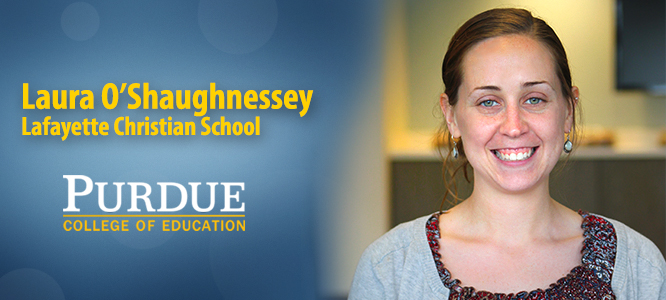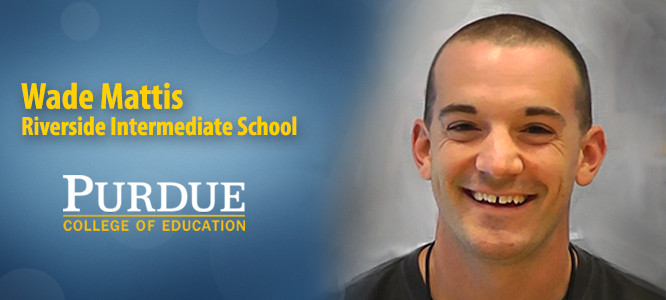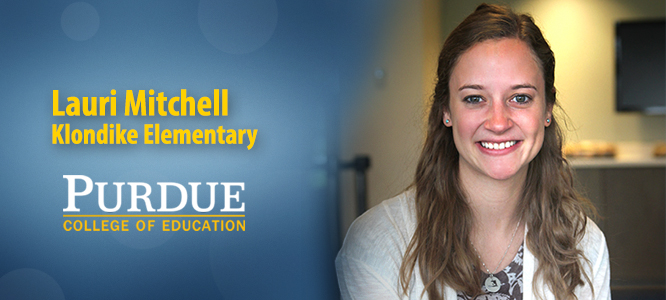Teachers Engineer Design-Based Science Projects at SLED Summer Institute
More than 120 Indiana teachers gathered at Purdue’s Discovery Learning Research Center for the SLED (Science Learning through Engineering Design) Institute in June. They explored new methods of teaching Indiana math and science curriculum standards in a way that incorporates science inquiry activities and engineering design challenges. This fall, they’ll return to their classrooms with interactive activities they learned at SLED, such as designing and testing a door alarm and creating a sun-tracking system using a solar panel. Below, read about three teachers and their experiences.

“My students love the activities I learned at the SLED institute,” says Laura O’Shaughnessey, who teaches sixth, seventh and eighth grade at Lafayette Christian School and has been coming to SLED since 2012. “The students take a lot of ownership in the activities because they are so hands-on,” she says.
SLED offers teachers a variety of engineering design activities to take back to their classroom – anything from creating a model of a prosthetic leg to designing a prototype of a roller coaster using foam insulation in order to learn about kinetic and potential energy. After the teacher introduces the design challenge to the class, teams of students create individual and group designs before constructing, testing and evaluating the project.
“Sometimes, my students get frustrated when their design doesn’t work the way they thought it would,” Laura says. “But once they start investigating why it didn’t work, they really have to think about the concepts we’re trying to teach them. For instance, with the roller coaster project, they have to understand that the marble didn’t make it all the way through the roller coaster because it didn’t have enough energy. Then they figure out how to fix it, and as a result, they understand the concepts associated with the project in a much more robust way.”

Wade Mattis, sixth grade teacher at Riverside Intermediate School in Plymouth, was exposed to SLED activities by working with colleagues who had participated in SLED training. “For the last three years,” he says, “I’ve been doing projects like roller coasters, bottle racers and solar trackers with my kids. It’s been a lot of fun, and they learn a lot of science topics.” Attending the 2015 SLED Summer Institute allowed Wade to expand his knowledge of the SLED design process. Wade says, “It put everything into perspective for me. I got to see how to actually design these projects, how to do pre- and post-activities and how to really get the kids thinking about the engineering process.”
For Wade, one of the most gratifying aspects of the SLED activities is their ability to engage his students. “Probably the most interesting one (and the one the students think is the most fun) is the roller coasters,” he explains. “I’ll get that kid that doesn’t like notebooking, doesn’t like doing his school work, but then when he gets his design task in front of him, he just goes crazy with it. He’s stepped up and has become a leader of that group and is taking complete ownership of the project.” The students are learning the key science concepts, like potential and kinetic energy, while also developing their skills and abilities. “I think that’s very rewarding, and as a teacher, that’s what you look for in kids,” says Wade.

Purdue alumna Lauri Mitchell attended the SLED institute as an undergrad in 2011, the summer before her senior year. This year, she attended SLED with her teaching team from Klondike Elementary, where she teaches fifth grade.
“Being part of SLED as an undergraduate was a huge learning experience. It was interesting to be around so many practicing teachers while I was an undergraduate, because in the teaching world, people are very open to sharing ideas.”
“It’s an honor to be back at SLED as an experienced teacher,” Lauri said, “because I have knowledge about what works and what doesn’t work when teaching these activities, and I’m able to give advice to the undergrad students and the practicing teachers who are new to the program.”
Growing up, Lauri wasn’t a huge fan of science. “I never really saw it as something that I would like to pursue as a career,” she said. “Even as a student at Purdue, I still was pretty convinced that science was going to be my least favorite subject to teach – until I found out about SLED. Something about the concept of giving the students design tasks and allowing them to develop their own solutions to the problems struck something in me, and I really wanted to check it out.”
“I’m always amazed at how many students take these projects and blow them out of the water,” she said. “Even students who don’t do the best in school – maybe because they don’t like to read or write or do homework. Those students do things with these projects that I never would be able to imagine. Frequently, the students who don’t really like school and don’t find a lot of success in school are the ones who find the most success in these projects.
“Because of the SLED Institute, I’ve learned that science can be so much broader than just doing experiments and studying specific concepts. It can become something that all students can access. By teaching STEM design principles, we can find strengths in all of our students, no matter what their normal school abilities might be.”